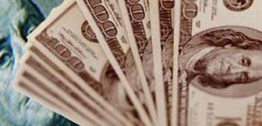[Editor’s note: I am currently traveling with my family back from our Asia home to our U.S. home. Hence, this is somewhat of an abbreviated issue. Once I am back in the States, I will seek to update you on important developments, even by flash alerts.]
It’s official … Donald J. Trump is the 45th President of the United States.
Now, buckle your seat belts — it’s going to get a lot more interesting before his first term in office is over!
And that couldn’t be more true as I sit back and take a good hard look at the financial markets right now. Stocks have rallied 10 percent since just before the election.
Meanwhile, Treasury bonds have been decimated with selling as yields surge higher, due to: “expectations of tax cuts and stimulus-driven inflation…” according to a Bloomberg article.
The talking heads on CNBC have convinced themselves the Fed has its collective finger on the trigger and can’t wait to raise rates three or four times this year to combat accelerating inflation.
Here’s my take: Baloney! Don’t believe a word of it.
Look, the Trump inauguration, was nothing but a sideshow. The new administration’s policies will unfold over time and there are bound to be big and fluid changes. Investors have priced in great expectations for Trump’s first 100 days. Specifically, they’ve priced too much into stock prices, and priced too much out of Treasury bond prices.
Now the “honeymoon” period is ending, and it’s time for some harsh reality to kick in … and this is no reality TV show like the Apprentice either … this is high-stakes politics, where Trump has NO previous experience.
That’s not to say President Trump won’t deliver on his campaign promises … I believe he will make every effort to put our money where his mouth is. But it’s not going to happen overnight. Yet that’s what markets have set themselves up for, and markets are bound to be disappointed.
Never forget that investing is ALL about getting the sequencing right. Here’s what to expect …
First, stocks are set up for an overdue correction, disappointing the fair-weather bulls who piled in after the election day. Retail investors are now piling into stock funds and ETFs like there’s no tomorrow.
Second, bonds have simply sold off too far too fast. And now speculators have amassed a record short position in five-year Treasury futures, and are heavily short the 10- and 30-Year Treasury contracts too.
Of course, the fast-money crowd tends to be exactly wrong at key turning points in the markets, and I expect they’re bound to get burned again very soon — with their wrong-way bets on both stocks and bonds.
As for inflation, economic growth is at a generation low, global debt is at record highs and still rising. This is a recipe for more deflation ahead, not runaway inflation. Not just yet.
More on my outlook for stocks and bonds in just a few minutes, but first let’s take a look back at my initial forecasts for 2017.
In my December issue, I laid out my top-five major forecasts, telling you — in no uncertain terms — that 2017 is going to be the year the world crosses the Rubicon and holy hell breaks loose.
I gave you insights into the strong dollar and into why so many other pundits are so dead wrong on it.
I told you about the next moves in gold and silver, which have thus far, been right on.
I told you more about collapsing sovereign debt markets … the next shoes to drop in Europe (now obvious, the humanitarian crisis) … and the coming wild swings in the Dow Industrials and equity markets.
In the weeks and months ahead, I will cover all those topics and more. Yes, they are urgent. But right now, I want to lay out more on the markets.
After all, the markets are the ultimate arbiter of the world, of the global economy, of geopolitics, war, and more.
All from the perspective of my background in economic anthropology and the history of the repetitive rise and fall of societies and civilizations.
My work is aided by deep historical databases, my Artificial Intelligence (AI) models and a Neural Net that can crunch infinite amounts of data to determine patterns and forecasts.
It’s how I pegged back in September that Donald Trump would win the election. It’s how I predicted Brexit and the collapse of the British pound.
Now, an update, plus on to some new forecasts and AI charts.
Gold Update:
I am not going to discuss fundamental forces in this issue. I’ll reserve that for future issues. There’s no shortage of them. It all depends on whether or not you understand them. Most investors don’t get it right. They don’t apply practical-world analysis based on history and repetitive cycles.
Instead, let’s go right to my latest AI Neural Net charts. First, a gold update, via my latest AI chart.
As you can see, gold has performed nicely with the AI forecast. As I pen this issue, it’s reached as high as $1,218.75 in the near February futures contract.
Other than a slight pullback scheduled for the January 20 period, a pullback that’s not guaranteed, gold is looking good — and should move higher into at least early April.
An important BUY signal to look for: A close above $1,220 followed by a weekly close above $1,470.00.
An important SELL signal to look for: A daily close below $1,163.60.
These are not to be used unless you hear from me, via a flash alert. For now, consider them intermediate support and resistance levels.
Note: Last month I said the overall tone for gold and silver was bearish. That is still true. We have not yet seen them break out. But they have indeed firmed up. And here’s another bullish piece of evidence that tells me we’re eventually headed substantially higher from here …
Mining Stocks Update:
Another very bullish sign is the fact that the precious-metal mining stocks are now leading the price of gold to the upside.
This is an important development, because at key market turning points — the top last August and again at the bottom in January — the mining stocks tend to lead the way (up and down) as they are doing right now.
That’s why I have a watchful eye on my select list of high-quality mining stocks. And I plan to both add to your existing positons and to issue new buy recommendations when the timing is right. But first, let’s be patient and await confirmation of this move once gold triggers an important buy signal as noted above.
Silver Update:
Silver has underperformed gold. But that won’t last long. Over the longer-haul, silver may outperform gold as it comes into new demand from all sorts of new technology.
But as you know, I favor gold; it’s more stable. Nonetheless, here is my latest AI chart for silver: On a closing basis, silver is tracking its AI chart nicely.
Up ahead: A rally into the early May period.
An important BUY signal to look for: A close above $22.97.
An important SELL signal to look for: A close below $14.57.
Clearly, silver has a wild-and-wooly range. Same deal as gold. Do not act on any signals unless you hear from me.
Let’s take a look at copper, a metal we have not looked at in a while. A metal that you would think would be galloping ahead, given upcoming trillion-dollar infrastructure projects in the U.S. … in China … and more.
Yet it’s not what you think. It appears copper should nosedive into early February, then recover.
But there’s no great rally looking ahead, except perhaps into April, then it’s a sideways affair.
Nevertheless, markets have an uncanny way of surprising investors. So I’m keeping a closer eye on copper and copper opportunities right now.
Now, platinum and palladium: Two markets we haven’t visited in some time. Why now? Because they are very sensitive to the rising war cycles. To international conflict. To trade, and more. So expect to hear a lot more about them in the future.
For now, we’ll start, not with the fundamentals, but with my latest AI forecasts. First, platinum: After an upcoming bottom, which is forecast to be around the time this issue publishes (late January), platinum looks like it’s headed for a pretty good rally into early May. Stay tuned. I’ll be looking for opportunities there.
Palladium? Not quite the same. We don’t get to see a rally until roughly March.
Not sure why, but we’ll find out.
Crude oil: Crude oil is not looking good until we get past March.
Crude oil prices are still hovering around $52.42 a barrel on the February futures contract, as this goes to press, following the agreement by OPEC and non-OPEC producers to cut oil production.
The market expects these cuts will reduce crude oil oversupply, which will keep prices well supported, but I don’t believe it for a minute.
Look, we’re talking about a group of countries that, geopolitically speaking, are normally at each other’s throats, and they are fierce competitors when it comes to oil production.
Even IF this deal holds up — and I’ll believe it when I see it — higher oil prices will wind up leading to a rise in domestic crude oil production here at home, simply offsetting the impact of OPEC cuts.
Already rig counts here in the U.S. are on the rise, so it’s just a matter of time before higher U.S. shale output equalizes OPEC’s cut. That’s exactly why my cycles and AI forecast charts are pointing decisively DOWN for oil prices.
That makes the current period critical for crude. We could see new lows, believe it or not. Notice the projected steep descent for crude oil for February/March.
Issue: Geopolitics. The U.S. is now in the energy driver’s seat and most of the world hasn’t figured that out yet.
Now, for a real treat for the grain aficionados out there and for my farmers: A quick look at wheat and corn, plus other agricultural commodities.
Wheat: After a nine-year bear market since March 2008, where wheat lost 68 percent of its value, I believe wheat has bottomed.
Fundamentals are coming together nicely, but more importantly, technical analysis is looking good as is the rising AI forecast.
I’m not looking for any great rallies there, yet, but opportunities in food companies are starting to really shape up.
Corn: Not quite the same, due largely to seasonal and harvest cycles.
But heading into mid-April, you would certainly want to avoid the steep drop portrayed by my AI model below.
It then looks like corn can begin a series of rallies (not shown) and a new bull market.
In fact, all of the agricultural commodities — including soybeans and the soft commodities (coffee, sugar, cocoa, etc.) look to be embarking on a new bull-market run to the upside. And I’ll be looking to take full advantage with timely trade recommendations when the time is right.
Last but certainly not least, updates to my AI charts for the Dow Industrials and U.S. 30-year bonds.
Dow Industrials: My latest AI Neural Net forecast chart for the Dow Industrials tells you just how overextended the stock market is right now. Here you can see that we should be right on the cusp of a decline. In fact, it’s somewhat overdue already.
Sixty percent of the Dow’s gains in the run-up to the recent high is due to just five big-cap stocks: Goldman Sachs Group Inc. (GS), UnitedHealth Group Inc. (UNH), JP Morgan Chase & Co. (JPM), Caterpillar Inc. (CAT), and Boeing Co. (BA).
Meanwhile, thousands of publicly traded stocks on the New York Stock Exchange and Nasdaq are floundering … or in outright bear markets. That’s very poor market breadth, and it spells trouble ahead for stocks, short term.
True, the Dow has indeed confirmed a long-term buy signal when it closed above 18,500 on the last trading day of November.
BUT as I have previously warned, that is not a trading buy signal. It is simply a macro-trend signal confirming my long-term forecast of at least Dow 31,000, and likely as high as Dow 45,000 … before it all comes crashing down.
In the near term however, the Dow is overextended and in need of a pause that refreshes the blue-chips for the next move higher.
What’s the worst case? Hard to say right now, but there should be very strong support now at the wide range of 17,500 to 18,500. The upper-end of that range means a pullback of about 7 percent, the lower-end means a correction of about 11 percent.
The lower it can get, the better. And I’ll be looking for you to buy at those lower levels.
Finally, on to bonds …
U.S. 30-year bonds: The Treasury bond market, as you already know, has taken its worst shellacking in nearly 26 years, confirming the sovereign debt crisis I’ve been warning you about.
However, the bond market is now not only the most oversold I have ever seen it but also subject to a potential massive short-covering rally.
Bonds should continue to bounce into late February, but then turn down sharply in their next leg down, spiking interest rates higher again.
If you own any notes or bonds whatsoever, you should already be out. If not, use the counter-trend rally that’s unfolding now to get out.
Then look to get speculatively short via this service, when I make the recommendation.
Basic Survival Strategies
Gold was on a roller-coaster ride in 2016. Soaring in the first six months of the year, then slumping badly from July through December. But now it’s 2017: A new year chock-full of new opportunities for the precious metals, and I aim to take full advantage of what should be the buying opportunity of a lifetime.
FIRST, continue to hold your physical gold as recommended. As a reminder: You should have bought on my previous recommendation at $1,207 and more recently at $1,250, 10 percent each time, your average is roughly $1,228.50. That means you should soon be in-the-money on these purchases.
And once gold closes above $1,220 followed by a weekly close above $1,470.00, as my models suggest, you will be sitting pretty. In fact, I will recommend adding to your physical holdings as soon as these buy signals are elected. Stay tuned.
Remember, these are long-term core emergency holdings. And if you followed my recommendations on these buys for 20 percent of 20 percent of the Basic Survival Strategies section, your total allocation should be no more than 4 percent of your entire liquid net worth (20 percent X 20 percent).
If anything changes, or I decide you should hedge your current holdings, rest assured I will notify you immediately in Real Wealth, or via a flash alert if necessary.
Continue to hold your …
nCore Gold Bullion (GOLDS), up 212.6 percent since originally recommended.
nSPDR Gold Shares (GLD), up 171.2 percent since my initial recommendation.
n Tocqueville Gold Fund (TGLDX), up 43.7 percent.
SECOND, hold any extraneous platinum or palladium you may have purchased, which should be very minor in holdings.
THIRD, for spot silver: You should have 5 percent of your Basic Survival Strategies funds invested in physical silver when it hit $16.30 on November 23. You’re up 5.2 percent on this buy. Hold. I will let you know when to add-to, or hedge the position if need be.
FOURTH, continue to hold Yamana Gold Inc. (AUY), Goldcorp Inc. (GG) and Kinross Gold Corp. (KGC) — with good-till-canceled protective sell-stops at $2.34 … $11.49 … and $2.25, respectively.
I’ll be looking to add to these positions soon, once my key buy signals are elected, as stated above.
Plus, I’m constantly scanning my watch list of high-quality miners with low production costs for new potential buy recommendations. Stay tuned, because I expect to add substantially to your mining stock holdings this year.
FIFTH, keep holding your shares in Vantiv, Inc. (VNTV) with a good-till-canceled sell-stop at $49.74.
If not on board, for whatever reason, using 3 percent of your capital allocated to Basic Survival Strategies, buy Vantiv, Inc., symbol VNTV, at the market. Place a good-till-canceled sell-stop at $49.74.




